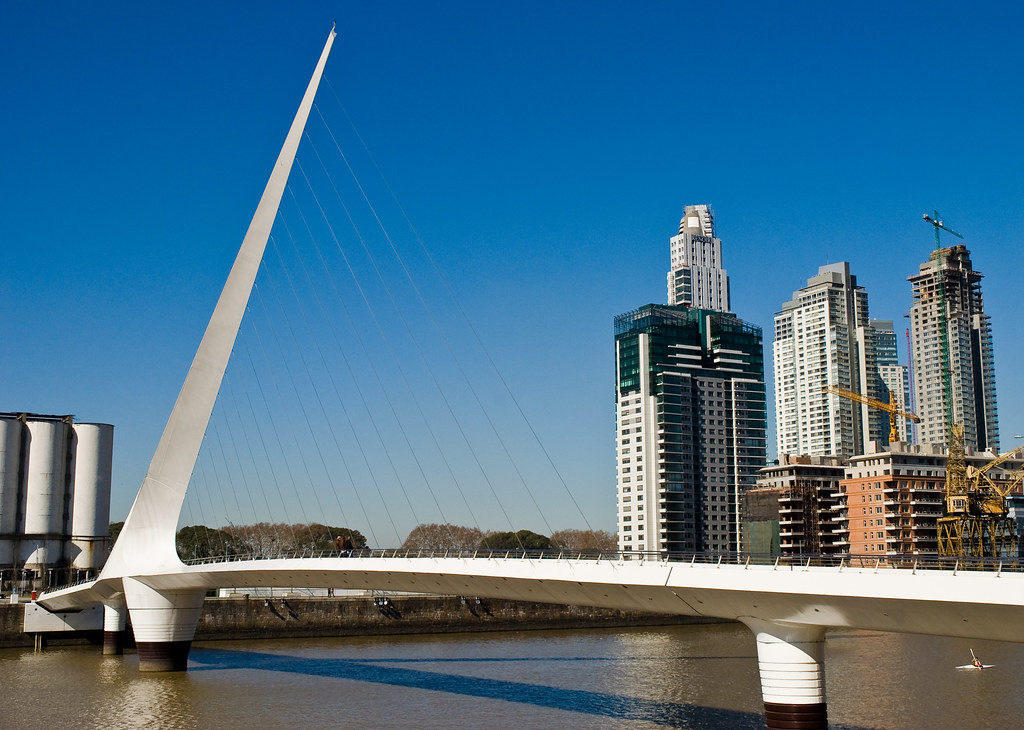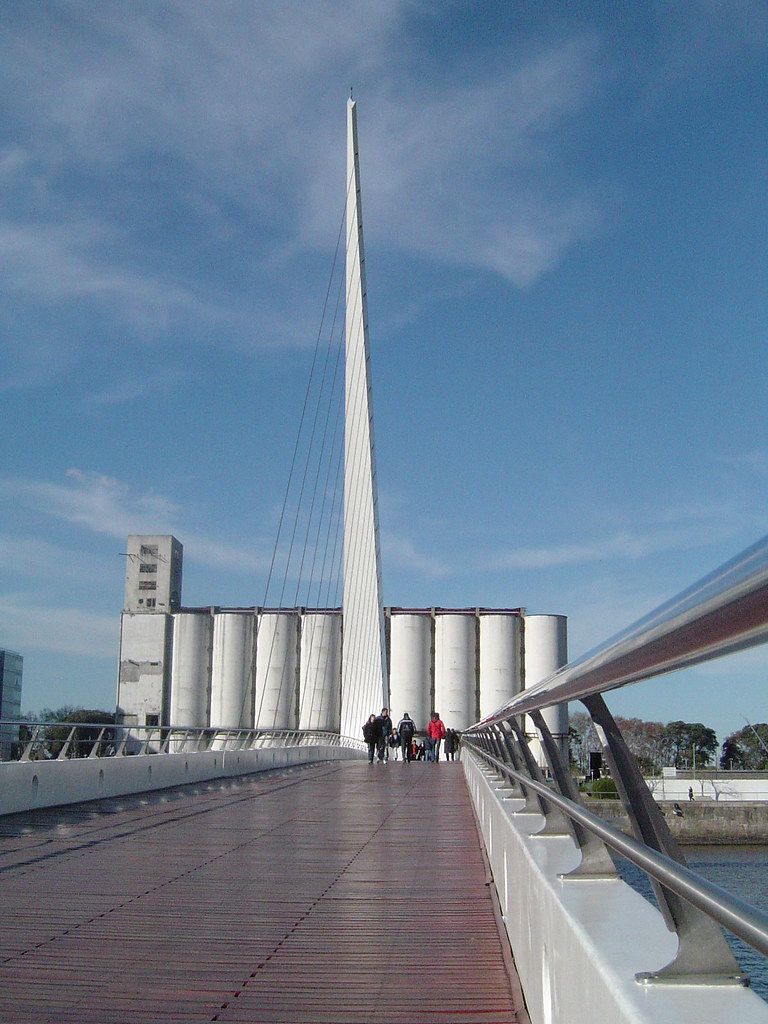Puente De La Mujer (Bridge Of The Woman)
Though many of Santiago Calatrava’s bridges—nearly 40 built so far—feature inclined pylons or arched forms, each example pushes the limits of structural ingenuity and sculptural grace in a different way. This architect/engineer has repeatedly reinvented the possibilities for asymmetrical, single-pylon, cable-stayed suspension systems—most recently with the pivoting Puente de la Mujer at Puerto Madero in Buenos Aires.

Donated by Alberto L. Gonzales and his family to this city of Buenos Aires, Santiago Calatrava's Puente De La Mujer (Bridge Of The Woman) is the architect's only work in South America. The 335-foot-long suspension pedestrian bridge is broken up into three sections, two static and one mobile. The central portion of the bridge was designed to rotate 90 degrees to allow water traffic to pass, with the two static portions connecting to pedestrian streets on either side of the dam. Most of the bridge's weight rests upon its central support, in which motors are located allowing the bridge to rotate. The bridge was primarily built in Victoria, Spain and taken to Buenos Aires in parts over five months. In its design, Puente De La Mujer is somewhat related to the Alamillo Bridge in Seville in its radical asymmetry and expressive tension, though its scale and angles are admittedly less grandiose and its asymmetry is reversed from the Seville bridge.
Calatrava is said to have requested examples of Argentina's typical music upon receiving this commission. As a result, the bridge is abstractly meant to illustrate a couple dancing Tango, the man towering over the woman who is leaning back horizontally. This, along with the fact that the surrounding neighborhood has streets primarily named after women accounts for the name of the bridge.
Calatrava is said to have requested examples of Argentina's typical music upon receiving this commission. As a result, the bridge is abstractly meant to illustrate a couple dancing Tango, the man towering over the woman who is leaning back horizontally. This, along with the fact that the surrounding neighborhood has streets primarily named after women accounts for the name of the bridge.
Dynamic in its sharp, arrowlike precision, the pylon, holding taut rungs of cables, reaches a height of 128 feet. Its great triangulating V-form leads with a crescendo from the axis of a major avenue, gesturing toward the new, higher part of the city on the opposite bank. The cable-strung V forms an acute angle in the structure, with concrete inserted as counterweight just behind its apex. The resulting silhouette, supporting a wood-planked pedestrian walkway, appears remarkably minimal and deceptively simple.
The bridge must improve pedestrian circulation and connect the plazas on either side of the embankment, while at the same time leaving unobstructed a dock that is still used for water traffic.The solution is a structure that consists of a rotating suspension bridge, 102m (335 ft) long, set between a pair of fixed approach spans. The central section is suspended by cables from an inclined pylon 39m (128 ft) high. This section of the bridge can rotate 90 degrees to allow free passage of water traffic. The weight of the mechanical tower balances the weight of the pylon, allowing the rotational system to be simplified.
The bridge must improve pedestrian circulation and connect the plazas on either side of the embankment, while at the same time leaving unobstructed a dock that is still used for water traffic.The solution is a structure that consists of a rotating suspension bridge, 102m (335 ft) long, set between a pair of fixed approach spans. The central section is suspended by cables from an inclined pylon 39m (128 ft) high. This section of the bridge can rotate 90 degrees to allow free passage of water traffic. The weight of the mechanical tower balances the weight of the pylon, allowing the rotational system to be simplified.
Porteños, as Buenos Aires residents are called, have long seen value in architectural monumentality and symbolism, as seen in their beloved obelisk, Casa Rosada, and even La Bombonera. Added to that list was Puente De La Mujer, which was seen as a symbol of a new era in Argentine history, and the new millennium. These hopes, however, were largely dashed due to the current disrepair that the bridge is in. Only three years after its inauguration the bridge has been closed for some time due to missing screws and slats of wood which make it unsafe for pedestrians. The city of Buenos Aires has never assumed responsibility for the bridge's upkeep, choosing instead to have the Gonzales family (who donated the $6 million bridge) to maintain it. The bridge is thus not operating, while its upkeep is sorted out. In the meantime, the bridge gives Puerto Madero a beautiful modern counterpoint to its brick industrial buildings which have recently been rehabbed to house restaurants, shops and lofts.


Measurements:
Total length: 525 ft.
Central rotating span: 335 ft.
Width of deck: 16.4 ft.
Height of pylon: 128 ft.
Gross square footage: 8,611 sq. ft.




0 comments:
Post a Comment